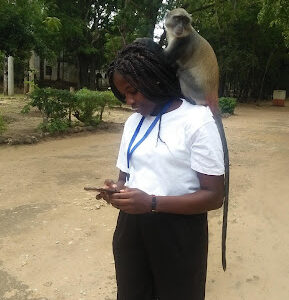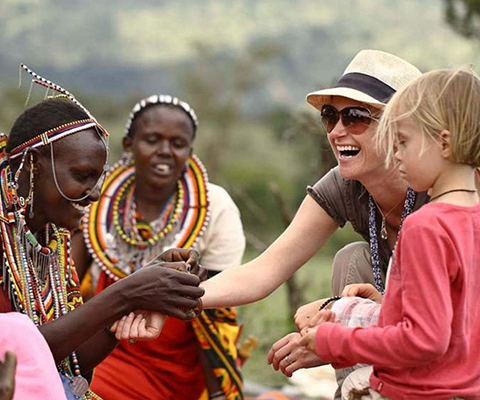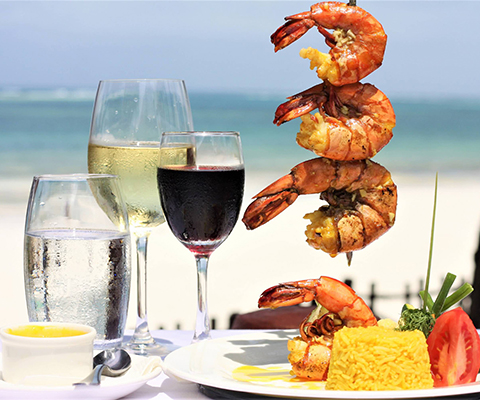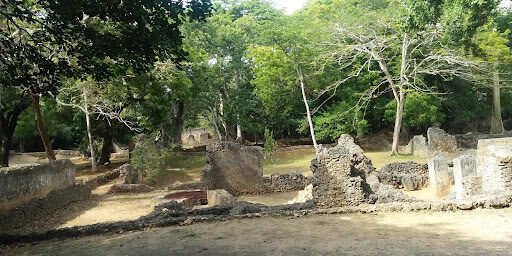Gedi Ruins National Monument is a historical and archaeological site found near Gedi town. It lies 16 km south of Malindi town and approximately 120 km northeast of Mombasa. Gedi Ruins National Monument is open seven days a week, including public holidays, from 7:30 am to 6:00 pm.
The site welcomes you with friendly little creatures, the syke’s monkeys. You can interact with these beautiful creatures and even enjoy the ‘monkey show’ where the monkeys climb on your heads and shoulders. Not only that. You can also take photos with them – the only catch is bringing some bananas sold at the park gates.

Sykes Monkey Gedi Ruins
Also read Fun places to visit in Malindi.
Gedi: An Ancient Arabic/Swahili Town
As the name suggests, Gedi Ruins are remnants of the ancient Arabic town. It is located in the Town of Gedi (Gede), Watamu, and sits on approximately 45-acre land extending to the Indian Ocean. It is also part of the Arabuko Sokoke National Reserve. The ‘Arab city of Gedi’ was initially known as Kilimani, as recorded in the map of 1639. Gedi is a Gala word with the following meaning:
- Precious
- Personification
- Movement
- Destruction
Gedi was established in the 12th Century and peaked in the 15th Century. It was later abandoned in the 17th Century due to four reasons, which were :
- Civil war
- Dryness of the well
- Invasion of the gala people
- The black plague disease
Gedi Ruins Pak is said to be 45 acres, but only 12 acres were excavated. It is estimated that about 2,500 to 3,000 people lived in Gedi. Experts found 36 houses in Gedi but only excavated 16. They also excavated 8 mosques, indicating that those who lived in Gedi were Muslims. These buildings were made of coral rags, coral lime, and soil.
Gedi Ruins has two walls, the inner wall and the outer wall. The inner wall was 7 feet high and had three gates; South, West, and East gate. The outer wall was 9 feet tall and had two gates; North and North West gate. The walls served two purposes, security and divisions of social classes:
- Those who lived in the inner wall were the wealthy merchants
- Those who lived between the walls were the middle-class people
- Those who lived outside the outer wall were the peasants
According to the available evidence, the residents were traders engaging in local and international trade. The excavation retrieved Chinese cash, Chinese porcelain, Venetian beads, and cowrie shells.
Also read: Mombasa Malindi road Trip
Years of Events
- 1884 – John Kirk, a British resident of Zanzibar, visited the ruins. The city was later forgotten until the 1920s when the local government, the [British East African Government], noticed his existence. The government later gazetted Gedi Ruins in 1927 as a national monument.
- 1939 – The government started public work of cementing the crumbling walls and reinforcing the house of the cistern, the only standing house with the original roofing in the city.
- 1948 to 1958 – James Karman was chosen as the first warden, and excavation started with the great mosque being excavated in 1954.
- 1969 – It was opened and handed over to the National Museums of Kenya trustee.
Reasons for Abandonment of the Town – Possible Explanations
Civil War
This was caused by the Sultan of Mombasa and the Sultan of Malindi when an explorer named Vasco da Gama came searching for a sea route to India. Vasco da Gama arrived in Mombasa, but the Sultan was hostile and did not welcome him since he wore a cross on his neck. The Sultan thought Vasco da Gama would change the religion from Islamic to Christianity.
But Vasco da Gama continued his journey until he came across Malindi town. The Sultan of Malindi was so welcoming; he even gave him land and a navigator hoping that Vasco da Gama would give him weapons. As a token of appreciation, Vasco da Gama built the first Vasco Da Gama Pillar in Malindi. He later returned home and narrated his encounter with the Sultan of Mombasa to his prince, Prince Henry.
The prince was angry with the Sultan of Mombasa and sent an army to fight the Mombasa people. After they defeated the Mombasa people, they built Fort Jesus. Mombasa people feared and sought assistance from Omani Arabs in Zanzibar. The Omani came and fought the Malindi people and won. In the process, they came across Gedi town, assuming the Malindi people had collaborated against them. This pushed the Swahili people to vacate the place.
Dryness of the Well
The residing oceans caused the wells to dry up. When the wells dried, there was no water for their animals, leading to the deaths of the Swahili people facilitating the place to be abandoned.
Invasion of the Gala People
Cushitic communities from Somalia had come to search for water and food for their cattle. The people of Gedi were so welcoming that they welcomed the Gala people. Later, when the wells started drying up, the Gala thought the Swahili people would send them away. Therefore, they decided to attack the Swahili people. Since the Swahili people did not want to fight back, they left.
The Black Plague
This disease was caused by rodents and did not have a cure. These rodents, such as rats, came with ships used during trading. This caused the death of many Swahili people and, eventually, a departure from the place.
Preservation of the Old Town
The town of Gedi has been around for a long time and is clear evidence of the beauty of history. It is thrilling to have to learn the history and then get to see it.
Most of the town is in ruins, with weak walls and structures. As such, tourists have been asked to refrain from stepping or leaning on the ruins, mostly the walls and other raised structures. But as you’d expect, more is needed – people still step on the stones and scribble their names on the wall.
The government should also partner with the National Museums of Kenya and enforce stringent laws to protect and preserve the ruins for future generations. Such laws may include enforcing a fine on anyone stepping on the ruins and putting up lines to limit contact with the fragile buildings. Educating people on the benefits of preserving the historical feature for our children and their children is also a great idea.
Other Fun Things to Do Inside the Gedi Ruins Historical National Monument
Besides exploring the ruins of Gedi, there are a host of other fun things that you can do inside the Gedi National Monument. These include:
Visiting the Ethnographic Gallery
The Ethnographic gallery is a room that displays several artefacts excavated from the ruins. It houses a range of pottery, earthenware, chinaware, silverware and ornaments from the ruins. It also has a side dedicated to showcasing the Swahili culture.
34Exploring the Butterfly House
The Gedi National Monument is also home to the Kipepeo House (butterfly house). Kipepeo House is a perfect place to enjoy the site of beautiful insect species at all levels of growth. It is a government project involving locals living near the Arabuko Sokoke Forest. These locals go through training to be butterfly farmers. They then rear and sell pupae to local and global markets.
Check out the Gedi Reptile Center
A few meters away from the ruins is the Gedi Reptile Center, home to a range of snakes. The center rescues stray reptiles and displays them for educational purposes. Take advantage of your visit to feel the thrill of touching the reptiles and taking photos with them under the supervision of a professional snake handler and a tour guide.
This story was covered by Anastacia Wamalwa, one of the tour guides in the Ruins of Gedi.










